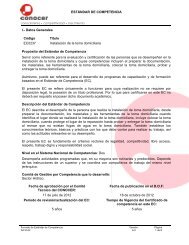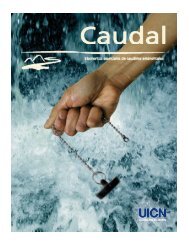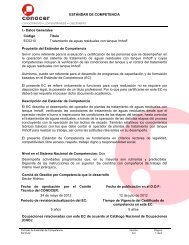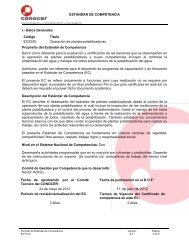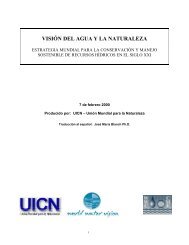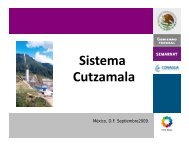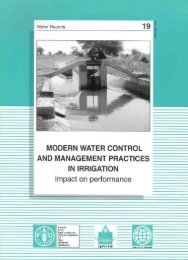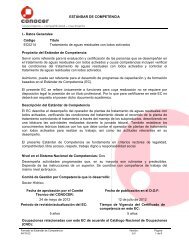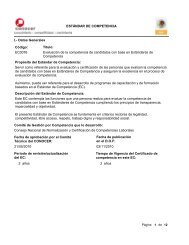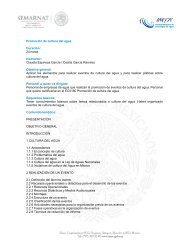Agricultural drainage water management in arid and semi ... - FAO.org
Agricultural drainage water management in arid and semi ... - FAO.org
Agricultural drainage water management in arid and semi ... - FAO.org
Create successful ePaper yourself
Turn your PDF publications into a flip-book with our unique Google optimized e-Paper software.
4IntroductionTABLE 1Sal<strong>in</strong>ized <strong>and</strong> dra<strong>in</strong>ed areas compared with total irrigated area, Central Asia <strong>and</strong> the Near EastCountry Irrigated area Sal<strong>in</strong>ized area Total dra<strong>in</strong>ed area surface +subsurface dra<strong>in</strong>ed% of% ofhaha irrigated area ha irrigated areaCentral AsiaKazakhstanKyrgyzstanTajikistanTurkmenistanUzbekistanNear EastBahra<strong>in</strong>EgyptIranJordanKuwaitLebanonMauritaniaPakistanSaudi ArabiaSyriaTunisiaTurkeySource: <strong>FAO</strong>, 1997a, 1997b.3 556 4001 077 100719 2001 744 1004 280 6003 1653 246 0007 264 19464 3004 77087 50049 20015 729 4481 608 0001 013 273385 0004 185 910242 00060 000115 000652 2902 140 5501 0651 210 0002 100 0002 2774 08060 0006.85.616.037.450.033.637.328.93.585.55.9433 100149 000328 6001 022 1262 840 0001 3002 931 00040 0004 000210 80012 7845 100 16544 000273 030162 0003 143 00012.113.845.758.666.341.190.30.66.2012.326.032.42.726.942.175.1%subsurface<strong>dra<strong>in</strong>age</strong> ofirrigatedareathan 0.5 million ha per year, <strong>in</strong>sufficient <strong>in</strong> their view to balance the current growth of affected<strong>dra<strong>in</strong>age</strong> areas. They estimate that: 10–20 percent of the irrigated l<strong>and</strong> is already equipped with<strong>dra<strong>in</strong>age</strong>; 20-40 percent of the irrigated area is not <strong>in</strong> need of any artificial <strong>dra<strong>in</strong>age</strong>; while 40–60 percent is <strong>in</strong> need of <strong>dra<strong>in</strong>age</strong> but rema<strong>in</strong>s without <strong>dra<strong>in</strong>age</strong> facilities. Table 1 shows examplesfrom countries <strong>in</strong> Central Asia <strong>and</strong> the Near East to illustrate their observations.In Central Asia, the present <strong>dra<strong>in</strong>age</strong> <strong>in</strong>frastructure is <strong>in</strong>sufficient to control irrigation-<strong>in</strong>duced<strong>water</strong>logg<strong>in</strong>g <strong>and</strong> sal<strong>in</strong>ity with a comparatively small percentage of subsurface dra<strong>in</strong>ed l<strong>and</strong>. Inaddition, the poor state of <strong>dra<strong>in</strong>age</strong> networks (due to lack of ma<strong>in</strong>tenance) has exacerbated<strong>water</strong>logg<strong>in</strong>g <strong>and</strong> sal<strong>in</strong>ity (<strong>FAO</strong>, 1997a).In the Near East, which is a region subject to sal<strong>in</strong>ity problems due to the prevail<strong>in</strong>g climateconditions, an average of about 29 percent of the irrigated areas have sal<strong>in</strong>ity problems. Table 1shows that for 12 countries <strong>in</strong> the Near East on average about 34 percent of the irrigated areahas been provided with <strong>dra<strong>in</strong>age</strong> facilities. For most countries no figures are available on thearea under surface versus subsurface <strong>dra<strong>in</strong>age</strong> (<strong>FAO</strong>, 1997b).In Pakistan, 13 percent of the irrigated area is reportedly suffer<strong>in</strong>g from severe sal<strong>in</strong>ityproblems <strong>in</strong> spite of the efforts made to provide <strong>dra<strong>in</strong>age</strong> <strong>in</strong> irrigated areas. Sal<strong>in</strong>ity problemspersist because of deficiencies <strong>in</strong> <strong>water</strong> policies <strong>and</strong> the low priority attached to the allocation ofresources for the operation <strong>and</strong> ma<strong>in</strong>tenance (O&M) of <strong>dra<strong>in</strong>age</strong> facilities <strong>in</strong> favour of <strong>in</strong>itiat<strong>in</strong>gnew projects (Martínez Beltrán <strong>and</strong> Kielen, 2000).On the other h<strong>and</strong>, under the <strong>in</strong>fluence of the grow<strong>in</strong>g world population <strong>and</strong> the <strong>in</strong>creas<strong>in</strong>gdem<strong>and</strong> for food, there is a trend of irrigation <strong>in</strong>tensification. To supplement scarce surface<strong>water</strong> resources, ground<strong>water</strong> is exploited through tubewell development, ma<strong>in</strong>ly <strong>in</strong> freshground<strong>water</strong> zones, all over the world. In many of these areas, the <strong>water</strong> table is decl<strong>in</strong><strong>in</strong>g due0.46.119.118.516.338.50.60042.1



